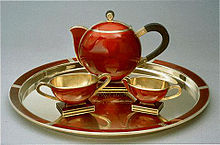Tea set

The examples and perspective in this article may not represent a worldwide view of the subject. (October 2014) |




A tea set or tea service is a collection of matching teaware and related utensils used in the preparation and serving of tea. The traditional components of a tea set may vary between societies and cultures.
History
The accepted history[1] of the tea set begins in China during the Han Dynasty (206–220 BC). At this time, tea ware was made of porcelain and consisted of two styles: a northern white porcelain and a southern light blue porcelain. It is important to understand that these ancient tea sets were not the creamer/sugar bowl companions we know today. Rather, as is stated in a third-century AD written document from China, tea leaves were pressed into cakes or bricks. These patties were then crushed and mixed with a variety of spices, including orange, ginger, onions, and flower petals. Hot water was poured over the mixture, which was both heated and served in bowls, not teapots. The bowls were multi-purpose, and used for a variety of cooking needs. In this period, evidence suggests that tea was mainly used as a medicinal elixir, not as a daily drink for pleasure's sake.
Historians believe the teapot was developed during the Song Dynasty (960–1279 AD) An archaeological dig turned up an ancient kiln that contained the remnants of a Yixing teapot. Yixing teapots, called Zi Sha Hu in China and Purple Sand teapots in the U.S., are perhaps the most famous teapots. They are named for a tiny city located in Jiangsu Province, where a specific compound of iron ore results in the unique coloration of these teapots. They were fired without a glaze and were used to steep specific types of oolong teas. Because of the porous nature of the clay, the teapot would gradually be tempered by using it for brewing one kind of tea. This seasoning was part of the reason to use Yixing teapots. In addition, artisans created fanciful pots incorporating animal shapes.
The Song Dynasty also produced exquisite ceramic teapots and tea bowls in glowing glazes of brown, black and blue. A bamboo whisk was employed to beat the tea into a frothy confection highly prized by the Chinese.
Chinese Yixing tea set
This is a Chinese Yixing tea set used to serve guest which contains the following items.
- A Yixing teapot
- A tray to trap the wasted tea/water.
- Cups to drink the tea.
- A Tea tool kit which contains the following: digger, funnel, needle, shuffle, tongs and vase.
- A brush to wipe the wasted tea all over the tray to create an even tea stain.
- A sieve—even if you pour tea from the pot, some tea leaf bits will still be poured out, so a sieve will help to filter out the loose bits during pouring.
- A clay animal or two. They are used for display and luck by many Chinese drinkers.
See also
References
- ^ Tea Set History Archived 2006-11-19 at the Wayback Machine, by Miriam Ellis, 2006
External links
- Tea sets at The Metropolitan Museum of Art, a small guide (fully available online as PDF)
